Heaven Is Made of Ice
Tribute and terror on skis in Antarctica

Ben Shook: ''This is a crazy place to strap skis to your feet.'' | Photos by Gabe Rogel
MY MUSCLES CLENCH AS I STARE 1,000 FEET DOWN the nameless 55-degree couloir we've just climbed. I'm on a narrow platform of hard snow that took me 15 minutes to chisel with my ice tool. Above our small party is a massive cornice; below, walls of granite plunge to form an hourglass with a waist 12 feet wide. The couloir funnels onto a large island of rock, making our planned ski descent a no-fall proposition. Five hundred feet beneath the rock, the chute spits over a bergschrund and then opens onto a glacier and sweeps down to the Errera Channel—full of icebergs and brash. Our waiting ship is just out of sight behind an icy headland to the south.

Author Ben Shook does a front flip off a glacier.
I nervously rehearse, acting out dropping through the couloir on my skis. My friend Gabe Rogel carefully steps off his platform, testing the three or four inches of Styrofoam snow over boilerplate ice. He initiates his descent with a jump turn, sending streamers of hardpack cascading down the chute. They disappear through the bellows and tinkle ominously against the rock island.
Gabe drops fast, linking his turns. I'm momentarily distracted from my anxiety. I can see that in the years since high school, Gabe has become an artist. And then he's standing safely under the granite. My anxiety returns—not just for myself, but for the two others with us, because Gabe has made it look easy. He and I were the ones who drove the bargain with our Kiwi guide, Sean, to climb and ski this couloir. And though Ted (our fourth) seemed keen to do it, I'm feeling a tickle of doubt. I am also truly aware for the first time—now many hours away from our ship's opiate of comfort—that we are in Antarctica.
GABE AND I HAVE TRAVELED to the bottom of the globe with One Ocean Expeditions, which has chartered the Akademik Ioffe. Russian-owned, with a crew of 43, it is an incredibly stout, ice-reinforced, 360-foot, six-deck, 13-million-pound steel fortress. Designed as a scientific research vessel, the Ioffe is transporting marine scientists, ornithologists, penguin researchers, mountain guides, photographers, an Antarctic historian, a physician, and a contingent of just-curious adventurers across the Drake Passage from South America to the polar continent. Gabe and I have come to take part in One Ocean's ski-touring program and, as long as we're here, to test kitesurfing in Antarctic waters.
Gabe and I became friends 20 years ago in high school, when we started climbing with the Spokane Mountaineers. On our own we explored the North Cascades, the Canadian Rockies, and British Columbia's Bugaboos. And though our deep fraternity was built through the church of climbing, it became stronger still one early-summer night on our way to an end-of-the-school-year party.
I was stoned and drunk, cruising in a passenger van through the rolling wheat fields of eastern Washington; the kegger was way out of town. Halfway to our destination, police cruiser lights illuminated the van. Our friend Jordan snapped to attention and ordered the stowage of half-drunk beers and paraphernalia. But the cops ripped past us. We shrieked for joy, relieved that we weren't headed to juvie and still thinking that we were on our way to a party. Ten minutes ahead, however, things froze into a nightmare when we saw a familiar baby blue Travelall on its side, off the road. One of our buddies, Jon Sanders, had tumbled out the open back window, and the truck had rolled over him.
Within our small group of young climbers, Jon was unique. He had a dignity and gentlemanliness out of keeping not just with his age but also with the era. His death checked our sense of invincibility and made us more aware of the shadows lying just beyond our climbing risks.
IN THE YEARS SINCE, Gabe has become a soft-spoken expert in the mountains. He has guided all over the globe with the American Alpine Institute, burnishing his craft in the Himalayas, Andes, Chugach, Tetons, and Alps. He now works as an action photographer, documenting extreme sports worldwide. Though we have gone in separate directions, Gabe and I manage to make some sort of mountain pilgrimage every year.
The Antarctica trip began with us skinning up a peak just outside Ushuaia, Argentina, above the Martial Glacier, working off a hangover. Because we'd agreed that I'd porter all the kite gear, Gabe had brought skis for both of us. As we climbed, I asked him about the older Black Diamond boards I was on. Gabe said that they'd belonged to the late Doug Coombs. I'd known that Gabe had skied with Doug, whose story gave me goose bumps.

Left: Once separated from the glacial mass, icebergs can wander the sea for thousands of years. Right: A bay that was as placid and open as a lake in the morning is impassable by afternoon.
Doug Coombs was a professional skier, self-effacing, high-energy, and famous for pioneering the sport of extreme skiing. In the spring of 2006, Gabe had taken a trip with him to Grand Teton National Park, Wyoming. As they passed an area called the Meadows, Doug remembered that he'd stashed a pair of skis there earlier in the season. They spent almost an hour looking for them, to no avail, with Doug laughing the whole time.
Doug died not long after on a trip in the French Alps. He was with three friends, skiing a big line with several dog-leg traverses that open up over immense cliffs, when one of his crew fell off the edge. As Doug approached the edge to look for him, he slipped on the icy rock and fell to his death.
Ten days later, Gabe was back in Grand Teton National Park again. There was much less snow, so he went looking for Doug's skis. And he found them. "Those are the skis you're on," he told me.
IN THE COULOIR, THE JOB of Doug's skis is to keep me alive. With each jump turn, I fall 15 feet and set my hip into the slope to check my speed. I'm not skiing as cleanly as Gabe, and a waterfall of hard snow plummets underneath me. I have the unmistakable feeling of engagement. I drop through the waist of the couloir and stop directly above Gabe, right at the granite tooth. I tap poles with my high school buddy, shaky and smiling. I turn to watch Sean maneuver through the chute, which now has less snow on it. He comes to a stop just above me, and I pat the back of his calf. He is also trembling, wearing a knowing grin.
Ted is still up on his platform. I have several half-formed thoughts: First, Ted is the only one of us on free-heel, or telemark, skis. Second, we have now scraped a lot of snow out of this couloir. And third, my and Gabe's eagerness to ski here has possibly eclipsed a critical question: Has Ted ever skied anything like this?
I cannot see Ted initiate his descent, but I know what is happening by watching Gabe's face. He is craning to look up the slope, and I see his expression transform to one of horror.
A week of dreamlike skiing did not prepare us for Ted's fall. Three days ago, we were dropped on a rocky beach on the south side of Spigot Peak, in the middle of a large chinstrap penguin colony of maybe 2,000 birds. As we schlepped our gear from the Zodiac, we were accompanied by a pod of crabeater seals, their thick shiny heads rooting about the boat. Surveying the jagged mountains, I thought, This is a crazy place to strap skis to your feet.
Six of us skinned up the low-angle glacier rising out of the Gerlache Strait, pushing toward a saddle that forks between several peaks. The weather cleared as we ascended, revealing sheer granite walls and falling glaciers, civilizations of ice and snow. It was an unbounded, insane environment, a kaleidoscope of repeating blue crevasses too lethal to stop to comprehend.

Entering the couloir, chatty dialogue stops and attention is metered by careful crampon placement and an exhale every time the ice tool grabs.
So we kept walking. We threaded a simple configuration of filled-in crevasses, snow-bridge keystones spanning fathoms of blue light. Sometimes we stole a glance into the darkly evolving luminescence. The ice reminded me of skin, sometimes cracked and old, sometimes buttery smooth. I saw animal shapes in it, faces, a storm trooper's helmet, my dad pruning an apple tree, an automobile.

Sign up to receive Sierra News & Views
Get articles like this one sent directly to your inbox weekly.
With this action you affirm you want to receive Sierra Club communications and may vote on policy designated by the Sierra Club Board.
We made the ridge by noon. The view opened up over another huge bay as well as onto the interior of the peninsula, where stacked ice floes and glaciers seemed to topple upward, stepping up to an ice plateau several thousand feet thick.
The place seemed invented, as strange as fiction. Then our group separated, some returning to the shore and the penguin colony. Gabe and I showed Sean a minor peak we wanted to ski on the way down. He pulled ahead of us, and then several yards up he removed his skis and started kicking steps up the slope. Meanwhile, Gabe and I kept disagreeing about the degree of exquisite, surreal beauty here. In the midst of what I can only call bliss, I sensed the presence of my dead friend Jon, and likewise felt the ghost of the man who had ridden the skis beneath my feet.
TED'S FREE FALL IS UNDER WAY for several seconds before he comes into view, tumbling head over heels and traveling so fast that each time he leaves the earth, he drops another 25 feet down the couloir, scalloping the snow. As he tomahawks past me, my only thought is of the granite island in the plumb line of his descent. Each time he strikes the slope, his body releases an involuntary hybrid of groan and scream. I guess that he's traveling at around 60 or 70 miles per hour. He flies out of view behind the rock and continues down the second half of the couloir until I can only hear him falling.
Then, silence. I scream his name. Nothing. Gabe stops me from descending and insists on going first. During my metered turns down after that—not knowing whether I am skiing to retrieve a body—I again remember where we are and that no Argentine first-response helicopter is likely to fly 800 miles across the Drake Passage for anybody.
When I reach the two of them, Ted is sitting up, blinking like a penguin. I ask him the basic concussion questions and about his neck. Then I perform a general body scan. There is something wrong with his ankle, and his face and head look like he has just come from a pub brawl. The fall has stripped him of his skis, gloves, poles, helmet cam (which is still filming), and backpack—even his jacket. Gabe and I look up at the divots where Ted hit the slope and see that he missed the granite island by inches. Not only is Ted not dead; he also appears to have escaped serious injury. I hug him, holding back tears.
Back at the ship, Gabe and I find Ted in his cabin with his broken ankle suspended in a jerry-rigged harness-and-webbing invention affixed to the little bookcase over his bed. He is in amazingly good spirits that only improve after a couple of beers. With rapt attention we watch the helmet-cam footage of the fall. We talk about what happened and all agree that we made a collective mistake by suppressing our anxiety up there.
THE NEXT DAY, THE IOFFE LEAVES the mainland peninsula, which gives me my only chance to kitesurf. I have a good 30 minutes before my drysuit blows a gasket, filling with 32-degree water. Soon after I take a hot shower, we make our last landing, on one of the South Shetland Islands, where I sit and observe. I find a quiet, though windy, place in a large chinstrap colony. After an hour of watching the penguins' comic behavior as they build their nests and prepare for the coming eggs, I become overwhelmed by a sense of fortune.
Years ago, when I lived in Paris, I would go to St. Eustache church every Sunday afternoon for the free organ concert. At the time, the organist didn't really play church music, but rather Bach fugues, Chopin etudes, Beethoven sonatas. They sounded unreal on that organ, one of the largest in the world. Beethoven's galloping, pounding bass octaves push you around. They require huge compression bellows, huge wind. One afternoon when I was there, I noticed a woman crying uncontrollably, her body contorting in paroxysms of sorrow. I basically knew what had happened to her. The only time in my life I have cried like that—one time—was at Jon Sanders's funeral.
With that memory of the weeping woman and the organ pipes framed by the penguins' affirmation of life, I recall a moment a few days earlier when we followed Sean up that minor peak. He was at the top, under the ridge cornice, chiseling out an attic door of sorts in the snow overhanging the slope we planned to ski. By the time Gabe and I arrived, Sean had fashioned a portal through the cornice. We climbed up, and it was as if we had taken an elevator through the ceiling of the world, with another dizzying view of that immense, clean, quiet museum. And we were not just here—which would have been enough—we were skiing here.
Maybe this is heaven? I wondered. Gabe and I looked at each other, and I thought, Perhaps this is the best way to love those who have gone before us: Go into the wild. It's the only place that could hold people like Doug Coombs and Jon Sanders, and that has wind enough to power the largest organ on Earth, blowing a song for your friend.
Jon and Doug are not dead. They are here. I know that if Jon would permit himself to dwell somewhere, anywhere, it would be right here. And we get to be here with him, with each other, for just a minute. Then we do what the living do: Go back down.
 The Magazine of The Sierra Club
The Magazine of The Sierra Club



